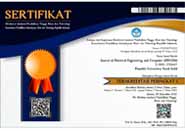T. Brown et al., “Language Models are Few-Shot Learners,” in Advances in Neural Information Processing Systems, H. Larochelle, M. Ranzato, R. Hadsell, M. F. Balcan, and H. Lin, Eds., Curran Associates, Inc., 2020, pp. 1877–1901. [Online]. Available: https://proceedings.neurips.cc/paper_files/paper/2020/file/1457c0d6bfcb4967418bfb8ac142f64a-Paper.pdf
Z. Latinovic and S. C. Chatterjee, “Achieving the promise of AI and ML in delivering economic and relational customer value in B2B,” J Bus Res, vol. 144, pp. 966–974, 2022, doi: https://doi.org/10.1016/j.jbusres.2022.01.052.
K. R. Chowdhary, “Natural Language Processing,” in Fundamentals of Artificial Intelligence, K. R. Chowdhary, Ed., New Delhi: Springer India, 2020, pp. 603–649. doi: 10.1007/978-81-322-3972-7_19.
P. M. Nadkarni, L. Ohno-Machado, and W. W. Chapman, “Natural language processing: an introduction,” Journal of the American Medical Informatics Association, vol. 18, no. 5, pp. 544–551, Sep. 2011, doi: 10.1136/amiajnl-2011-000464.
M. Bahja, “Natural Language Processing Applications in Business,” in E-Business, R. M. X. Wu and M. Mircea, Eds., Rijeka: IntechOpen, 2020, p. Ch. 4. doi: 10.5772/intechopen.92203.
S. F. Chen and J. Goodman, “An empirical study of smoothing techniques for language modeling,” Comput Speech Lang, vol. 13, no. 4, pp. 359–394, 1999, doi: https://doi.org/10.1006/csla.1999.0128.
M. Sundermeyer, R. Schlüter, and H. Ney, LSTM Neural Networks for Language Modeling. 2012. doi: 10.21437/Interspeech.2012-65.
T. Mikolov and G. Zweig, “Context dependent recurrent neural network language model,” in 2012 IEEE Spoken Language Technology Workshop (SLT), 2012, pp. 234–239. doi: 10.1109/SLT.2012.6424228.
S. Hochreiter and J. Schmidhuber, “Long Short-Term Memory,” Neural Comput, vol. 9, no. 8, pp. 1735–1780, Nov. 1997, doi: 10.1162/neco.1997.9.8.1735.
A. Radford, K. Narashiman, T. Salimans, and I. Sutskever, “Improving Language Understanding by Generative Pre-Training,” OpenAI, 2018, [Online]. Available: https://openai.com/blog/language-unsupervised/
C. M. Gevaert, M. Carman, B. Rosman, Y. Georgiadou, and R. Soden, “Fairness and accountability of AI in disaster risk management: Opportunities and challenges,” Patterns, vol. 2, no. 11, p. 100363, 2021, doi: https://doi.org/10.1016/j.patter.2021.100363.
A. Chan, “GPT-3 and InstructGPT: technological dystopianism, utopianism, and ‘Contextual’ perspectives in AI ethics and industry,” AI and Ethics, vol. 3, no. 1, pp. 53–64, 2023, doi: 10.1007/s43681-022-00148-6.
R. Dale, “GPT-3: What’s it good for?,” Nat Lang Eng, vol. 27, no. 1, pp. 113–118, 2021, doi: DOI: 10.1017/S1351324920000601.
D. Luitse and W. Denkena, “The great Transformer: Examining the role of large language models in the political economy of AI,” Big Data Soc, vol. 8, no. 2, p. 20539517211047736, Jul. 2021, doi: 10.1177/20539517211047734.
S. Y. Kim, H. Park, K. Shin, and K.-M. Kim, “Ask Me What You Need: Product Retrieval using Knowledge from GPT-3,” Jul. 2022, [Online]. Available: http://arxiv.org/abs/2207.02516
G. Generative Pretrained Transformer, A. Osmanovic Thunström, S. Steingrimsson, and S. Steingrimsson Can, “Can GPT-3 write an academic paper on itself, with minimal human input? GPT-3 write an academic paper on itself, with minimal human input?” [Online]. Available: www.openai.com
A. M. TURING, “I.—COMPUTING MACHINERY AND INTELLIGENCE,” Mind, vol. LIX, no. 236, pp. 433–460, Oct. 1950, doi: 10.1093/mind/LIX.236.433.
Kevin Lacker, “Giving GPT-3 a Turing Test,” Jul. 06, 2020.
Y. Wang, Q. Yao, J. T. Kwok, and L. M. Ni, “Generalizing from a Few Examples: A Survey on Few-Shot Learning,” ACM Comput. Surv., vol. 53, no. 3, Jun. 2020, doi: 10.1145/3386252.
D. Haluza and D. Jungwirth, “Artificial Intelligence and Ten Societal Megatrends: An Exploratory Study Using GPT-3,” Systems, vol. 11, no. 3, 2023, doi: 10.3390/systems11030120.
R. Singh, V. Garg, and GPT-3, “Human Factors in NDE 4.0 Development Decisions,” J Nondestr Eval, vol. 40, no. 3, p. 71, 2021, doi: 10.1007/s10921-021-00808-3.
Thomas J Ackermann, “GPT-3: a robot wrote this entire article. Are you scared yet, human?,” Artificial Intelligence: ANI, LogicGate Computing, AGI, ASI, Nov. 29, 2020.
M. Zhang and J. Li, “A commentary of GPT-3 in MIT Technology Review 2021,” Fundamental Research, vol. 1, no. 6, pp. 831–833, 2021, doi: https://doi.org/10.1016/j.fmre.2021.11.011.
B. Ding, C. Qin, L. Liu, L. Bing, S. Joty, and B. Li, “Is GPT-3 a Good Data Annotator?,” Dec. 2022, [Online]. Available: http://arxiv.org/abs/2212.10450
B. Lester, R. Al-Rfou, and N. Constant, The Power of Scale for Parameter-Efficient Prompt Tuning. 2021. doi: 10.18653/v1/2021.emnlp-main.243.
A. Vaswani et al., “Attention is all you need,” Adv Neural Inf Process Syst, vol. 2017-Decem, no. Nips, pp. 5999–6009, 2017.
J. Devlin, M. W. Chang, K. Lee, and K. Toutanova, “BERT: Pre-training of deep bidirectional transformers for language understanding,” NAACL HLT 2019 - 2019 Conference of the North American Chapter of the Association for Computational Linguistics: Human Language Technologies - Proceedings of the Conference, vol. 1, no. Mlm, pp. 4171–4186, 2019.
I. Radford, A., Wu, J., Child, R., Luan, D., Amodei, D., and Sutskever, “Language Models are Unsupervised Multitask Learners,” OpenAI Blog, 2019, [Online]. Available: http://arxiv.org/abs/2007.07582
 (Informatics & Business Institute Darmajaya)
(Informatics & Business Institute Darmajaya) 








